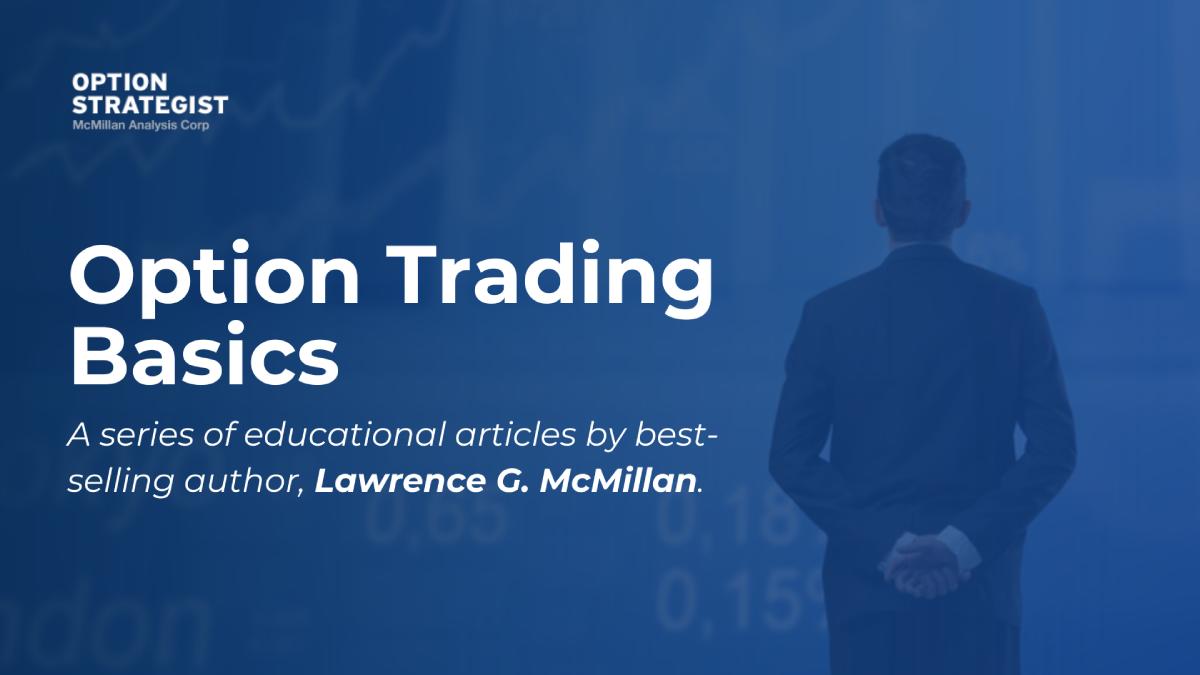
By Lawrence G. McMillan
This article was originally published in The Option Strategist Newsletter Volume 4, No. 2 on January 26, 1995.
One of the most important features of options is that they can remove some or all of the risk of stock ownership (or futures, where futures options are concerned). This is particularly attractive to stock owners who want some form of "insurance" against a steep or prolonged market decline.
There are several ways in which options can be used as an insurance policy for one's portfolio of stock. One might sell calls, or he might buy puts, or he might do both. In any case, these option transactions would profit if stocks fell and that profit would offset some or all of the losses incurred by stocks owned during the market decline. These concepts are not complicated and are used by many stock owners, particularly professional money managers.
As with many strategies, the concepts may be clear, but the application is more complicated. For example, if one wants to protect his stock portfolio, he needs to answer the following non-trivial questions: Should calls be sold or puts be bought? Which puts should be bought? Should they be equity or index puts? How many puts are required to adequately hedge the portfolio? To fully answer all of these questions would require the entire newsletter, but we can provide some useful ideas.
First, as to whether one should buy puts or sell calls, one must decide what he wants his insurance to do. When one owns fire insurance on his house, he is not hoping to hedge a little if a meaningless wastebasket fire breaks out; rather he is looking for disaster insurance in case the whole house burns down. Using options as portfolio insurance is similar: buy puts if you want to be protected in case of a crash or a fast-moving bear market — i.e., if you want disaster insurance. We will talk about when the sale of calls may be a good adjunct to insurance later in this article.
As far as which puts to buy, one again can assess the amount of protection needed. If one only needs true disaster insurance, then he should buy out-of-the-money puts — perhaps several strikes below the current stock price. However, if he feels that he needs immediate insurance in case of a market decline, then he might want to buy puts with strikes quite close to the current stock price. Obviously, the more protection one desires (i.e., the higher the strike price of his puts), the more expensive the insurance will be. This is true of any form of insurance.
Equity puts are generally cheaper than index puts, so if one has a small portfolio, he might decide to buy individual equity puts against each stock that he owns. However, if he has a rather large and diverse portfolio, then the best tack is to buy index puts, for they are liquid and a lot of protection can be purchased with one order.
It can be somewhat tricky to determine how many index puts to buy to properly hedge your portfolio. In order to do so, one must convert his portfolio into "Beta dollars" in order to measure its volatility. If a stock has a Beta of 2.0, then it moves twice as fast as the "market". One should sum the following for each stock in his portfolio: stock price × number of shares owned × stock's Beta (if you don't have a list of your stocks' Betas, you can use implied volatility of the options — just divide the stock's implied volatility by the implied volatility of the OEX index or S&P 500 index, and you will have a "Beta" that is reasonable).
The sum of these multiples is the "Beta dollars" of the portfolio. That sum can then be divided by the strike price of the put being used for protection in order to determine how many puts to buy. For example, if one were considering using the OEX Dec 400 puts for protection, then he would divide the "Beta dollar" sum by 40,000 (the strike price times the number of "shares" of OEX represented by each option: 400 × 100). If one were using S&P 500 futures options as protection, he would divide by the strike price times 500 since each point is worth $500 for S&P 500 futures options.
There are two problems regarding using puts as insurance. First is that the market may rally substantially and then collapse, which means that your insurance was at too low a price compared to the market's eventual peak. There is no remedy for this, except to roll your puts up if the market rises substantially after you have already purchased your insurance. The second is that one is buying index options, which we know are usually quite expensive. Some professional traders prefer to offset some or all of the cost of the insurance by also selling out-of-the-money calls when the insurance is bought. This strategy is called a "collar" and limits one's profits on the upside and also limits ones losses on the downside. It results in a position with profit potential similar to that of a call bull spread.
If you think that 1995 will be a market peak, or you feel that the market is too overvalued, but you want to retain some equity ownership, then you should consider buying index puts for insurance purposes. The December '95 or December '96 OEX LEAPS puts (symbols OLX and OCX, respectively) would be the best choices.
This article was originally published in The Option Strategist Newsletter Volume 4, No. 2 on January 26, 1995.
© 2023 The Option Strategist | McMillan Analysis Corporation

